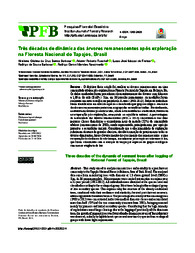Três décadas de dinâmica das árvores remanescentes após exploração na Floresta Nacional do Tapajós, Brasil.
Três décadas de dinâmica das árvores remanescentes após exploração na Floresta Nacional do Tapajós, Brasil.
Author(s): BARBOSA, H. C. da C. B.; RUSCHEL, A. R.; FREITAS, L. J. M. de; BARBOSA, R. de S.; NASCIMENTO, R. G. M.
Summary: O objetivo deste estudo foi analisar as árvores remanescentes em uma comunidade arbórea pós-exploração na Floresta Nacional do Tapajós, em Belterra, PA. Os dados analisados foram procedentes do monitoramento das árvores com diâmetro a 1,30 m do solo (DAP) ? 5cm, em 36 parcelas permanentes. As medições foram realizadas em nove c 31 anos (1981-2012). Todos os indivíduos foram identificados em nível de espécie e classificados por grupo ecológico. A maioria das árvores remanescentes pertencem ao grupo das secundárias tardias. Possivelmente, a estrutura das árvores já estabelecidas, aliada à sua resiliência e elasticidade, favoreceu a recuperação pós-exploração, avançando ao equilíbrio natural. A percentagem da mortalidade das árvores remanescentes (1981 a 2012) concentrou-se nas duas menores classes diamétricas e acumularam mais da metade (52%) da comunidade arbórea (remanescentes de 1981), sendo representada, principalmente, por espécies pioneiras e secundárias iniciais. Considerando que a alta intensidade de exploração refletiu em abertura de grandes clareiras, devido à remoção de praticamente todas as árvores dominantes, houve favorecimento do crescimento das remanescentes e uma recuperação da dinâmica do sub-bosque, inicialmente pelas espécies tolerantes à luz, que foram substituídas com o avançar do tempo por espécies de grupos ecológicos com menor exigência de luz. Abstract. This study aimed to analyze remnant trees and mortality in a post-harvest community in the Tapajós National Forest in Belterra, State of Pará, Brazil. The analyzed data came from monitoring trees with diameter at 1.3 above ground level (DBH) ? 5cm, in 36 permanent plots. Measurements were carried out on nine occasions over a 31-year period (1981-2012). All individuals were identified at the species level and classified according to the ecological group. Most trees belong to the ecological group of late secondary species. This explains why the structure of the already established trees, combined with their resilience and elasticity, favored post-harvest recovery, advancing towards the natural balance.The percentage of mortality of the remaining trees (1981 to 2012) was concentrated in the two smallest diameter classes and accumulated more than half (52%) of the tree community (remnant from 1981), being represented mainly by pioneers and initial secondary species. Considering that the high intensity of exploitation caused large clearings due to the logging of practically all the dominant trees, the growth of remnant trees was favored and a dynamic recovery of the understory was observed, initially by light-tolerant species and over time by species from ecological groups with lower light requirements.
Publication year: 2024
Types of publication: Journal article
Unit: Embrapa Forestry
Observation
Some of Embrapa's publications are published as ePub files. To read them, use or download one of the following free software options to your computer or mobile device. Android: Google Play Books; IOS: iBooks; Windows and Linux: Calibre.
Access other publications
Access the Agricultural Research Database (BDPA) to consult Embrapa's full library collection and records.
Visit Embrapa Bookstore to purchase books and other publications sold by Embrapa.

